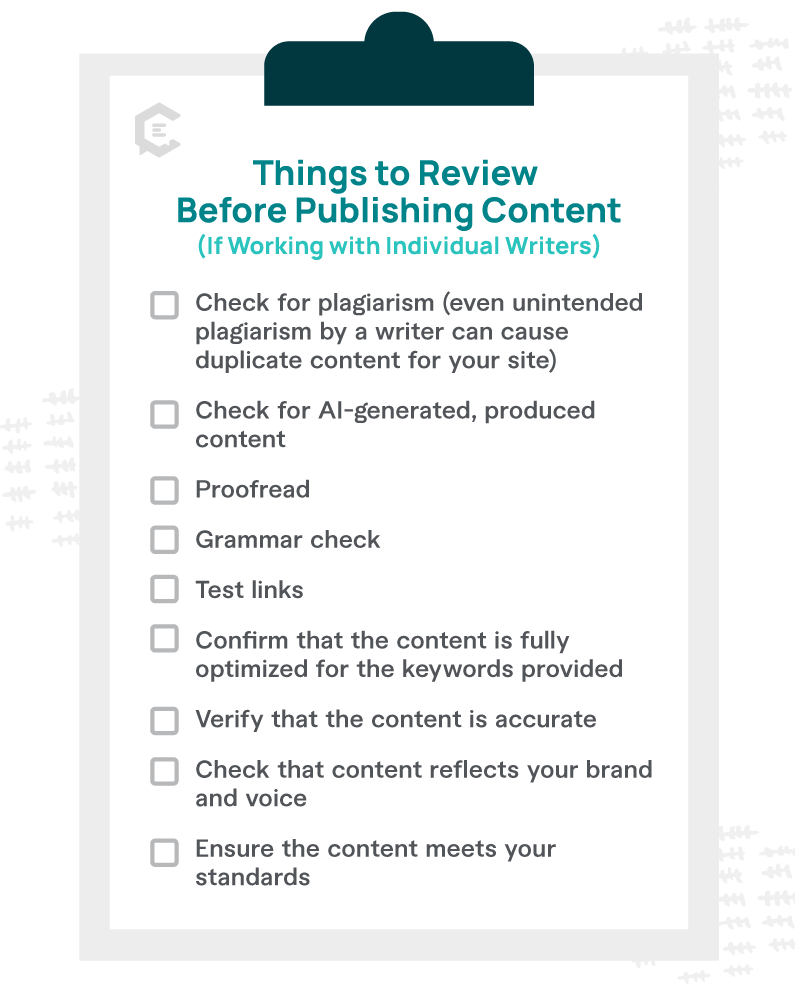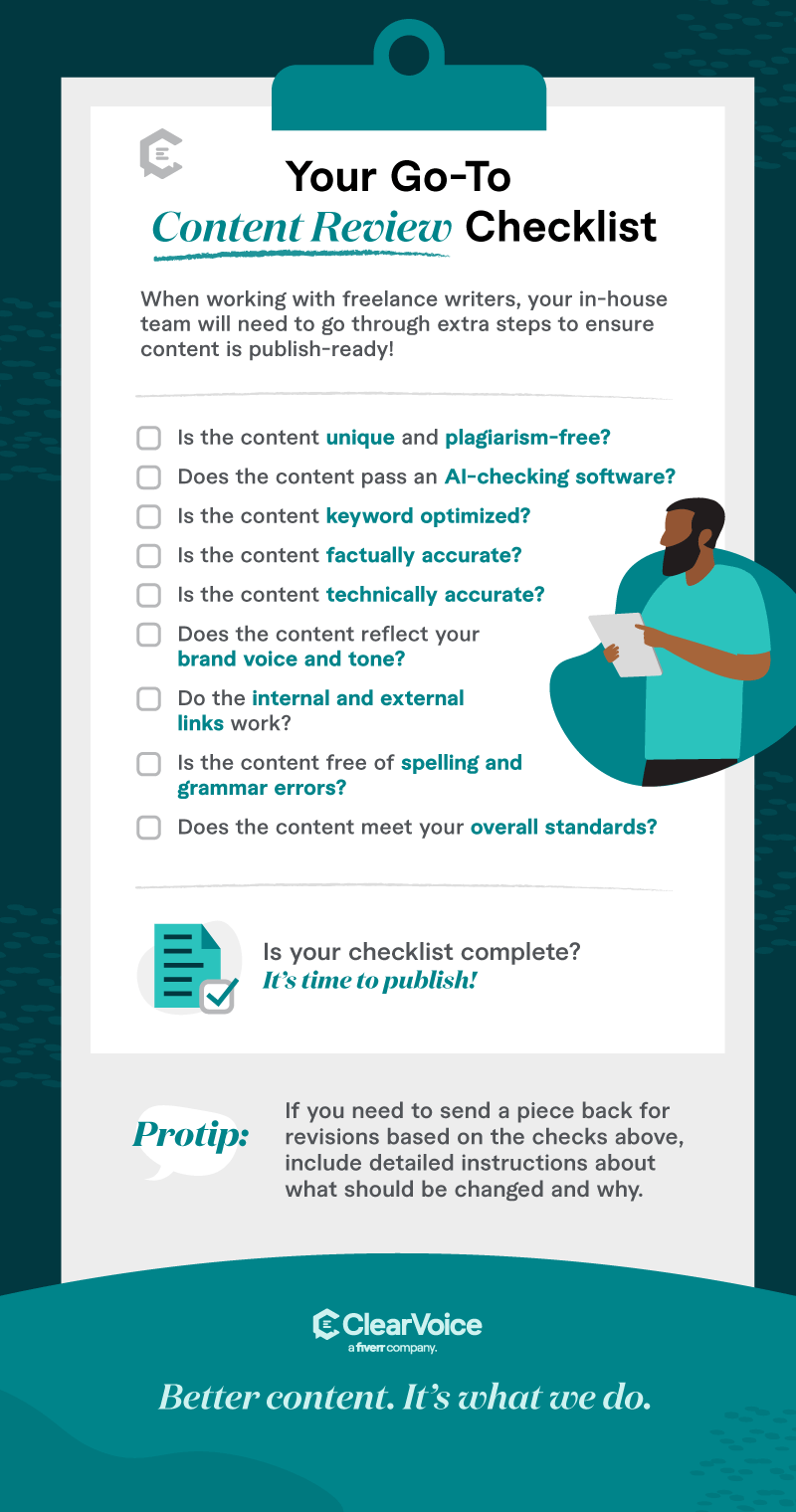Content marketing is all about consistency — but it takes time to plan and create content regularly. Sometimes it’s smarter and more cost-effective to leverage outsourcing your content creation.
Some companies choose to hire a professional content writer or two, while others outsource the entire production process to a content agency. This guide will provide you with a comprehensive overview of outsourcing your content, regardless of which route you take.
A Step-by-Step Guide to Outsourcing Your Content
When you outsource content creation to a professional, you free up your time for other tasks and put your content marketing in the hands of a seasoned pro. You might choose to work with individual content specialists to help with writing, editing, or strategy. Alternatively, you can opt for a full-service solution that takes the entire workload off your desk.
Working with a content marketing specialist or service is the best way to ensure a consistent stream of high-quality, engaging content. You can confidently outsource your content creation by following these steps and involving your team in the decision-making process.
Step 1. Get Clear About Your Goals
What do you hope to accomplish with your content marketing? Without a clear goal, it won’t be easy to measure your content’s success or justify outsourcing’s expense.
Some common goals for business content include:
- Position yourself as an expert in your field
- Generating leads and sales
- Increasing web traffic
- Boosting engagement with your brand
- Improving customer retention
- Educating your target audience
Think about what you want to achieve, and be specific. Once you have a goal in mind, you can start to think about the kind of content that will help you reach it.
Step 2. Gather Information About Your Business
The more information you can share with a content specialist, the better. Here are some of the details you might want to specify to them:
- Brand identity & voice
- Mission statement
- Unique selling proposition
- Target market & buyer personas
- Keywords & SEO goals
- Primary competitors
- Links to existing content
- Previous studies, surveys, or research you’ve conducted
If you’re a marketing professional at a larger company, you probably have this information at hand. However, if you’re a small or new business that hasn’t developed all these metrics, your content marketing specialist should be able to guide you — and you’ll find the process super valuable.
Step 3. Think About Which Tasks to Outsource
There are many components to creating marketing content, from strategizing to keyword research to writing and editing posts. Some companies prefer to outsource all of it so that an agency can manage it as a cohesive whole. But it’s also possible to keep some tasks in-house and experiment with outsourcing specific elements, like writing or strategy.
In a 2021 survey, 97 percent of marketers said that content was an important part of their overall strategy. And yet, only 57 percent said they had a documented content marketing strategy in place. If your company has a clearly documented strategy, you may want to jump straight to hiring writers. But if your strategy isn’t fully realized, you might want to start by bringing in a pro to help you refine and document your content plan.
Here are some content marketing tasks you might outsource:
- Strategy & planning
- Topic ideation & research
- SEO keyword research
- Writing
- Editing & proofreading
- Content promotion
- Graphic design & image sourcing
If your team has the time and knowledge to do some of this work in-house, you might want to outsource only the tasks you don’t enjoy or that take you out of your area of expertise. For example, if you’re a great writer but not so good at generating ideas, outsource the brainstorming and keep the writing in-house.
However, keep in mind that you’ll need to manage and communicate with each specialist you hire. Many companies opt for a fully-managed content marketing solution so they don’t have to supervise each aspect of the work.
Step 4. Consult with Your Content Specialist
At this point, you’re ready to talk to an outside professional. Based on the decisions you’ve made, you may be speaking with individual content creators, or you may be working with a fully-managed service.
If you don’t already have someone in mind, here are some factors to consider when you’re deciding who to hire:
- Do they have any relevant experience or expertise?
- Can they provide examples of their previous work?
- Are they a good fit for your brand’s tone and style?
- Do they understand SEO optimization?
- How well do they communicate?
- What is their process for content creation?
- Can they meet your deadlines?
- What are their rates?
An experienced pro will ask you questions in return. If they ask about your goals, target market, and brand identity, you’ll know you’re talking to a marketing professional who knows how to craft compelling content and has your best interests at heart.
When you’ve decided who you want to work with, find out more about their process and discuss how they can tailor their services to fit your budget.
Some questions you might want to ask your content specialist include:
- How do you determine which topics to write about?
- How much input will I have in the content creation process?
- What is your quality control process?
- What happens if I’m not happy with a piece of content?
- How often will I receive reports or updates on the project’s progress?
- What are your rates?
- Can you give me a discount if I commit to a long-term contract?
Step 5. Make Some Decisions
Now that you’ve set your goals and gathered information internally and externally, it’s time to make some decisions about how you want to proceed. Start by meeting with your team and discussing what you learned from the content planner.
Make sure you’re all on the same page about which tasks to outsource, what kind of specialist(s) you need, and how much you’re willing to spend. If you’ll be keeping some tasks in-house, consider who will be responsible for that work. If you’ll be contracting directly with writers, discuss who will manage them, edit the work, and create keyword strategies.
Also, discuss the metrics you’ll use for measuring your goal progress, and specify who in your company will be the liaison for working with your new associates.
When your team is in full agreement, you’re ready to set your content production in motion!
Step 6. Craft Your Agreement
When you’re ready to hire, sit down with your contractor or agency and hammer out all the details of your agreement in writing. If you’re working with an experienced team, they will already have a contract, and you may only need to read and sign it.
On the other hand, if you’re hiring individual writers, strategists, editors, or other specialists, you may need to provide the contract yourself.
Either way, the agreement should be clear about the budget, variables, schedule, and goals. For example, if you’re contracting with a writer, your understanding should clearly answer questions like these:
- How many pieces of content will you receive each month?
- Who will be responsible for doing keyword research?
- What will be each piece’s average word count or word count range?
- Will images be included?
- Will the work be proofread, edited, and checked for plagiarism?
- How many revisions can you request before there’s an extra fee?
- When is payment due?
If you’re outsourcing to a fully managed team, the agreement should also specify what kinds of reports or updates you’ll receive and how often. Make sure to include a section on quality control so everyone is clear about expectations for the finished product.
Step 7. Strategy Comes First
In a recent survey by the Content Marketing Institute, 71 percent of the respondents agreed that their company needs a content marketing strategy. And yet only 33 percent said that their company has a documented content marketing strategy.
With all the background elements and processes in place, you are ready to lay out your content marketing strategy. This might include some or all of the following:
- A list of keywords you intend to target
- Your brand voice and identity
- The brand stories you plan to tell
- Your target market
- Your goals
- External and internal linking strategies
- Obstacles and opportunities
- Analysis of your competitor’s content
- Analysis of your existing content
- Resources you prefer to cite as research or external links
- The channels you’ll use to publish and promote your content (blog, social media, podcasts, video channels, etc.)
Your content strategy will serve as a guide for all the content you produce, so it’s essential to get it right. If you’re working with an agency or other specialist, they will either create the strategy for you or help you fine-tune your ideas according to their expertise and experience.
Step 8. Work out Your Process
If you’re hiring a full-service agency to do everything from strategy to execution, the process at your end will be fairly simple — mostly approving the work, receiving reports, and giving feedback to the team.
However, if you’re only hiring a content writer or other specialist, you’ll be doing many tasks in-house, and your team will need a clear workflow, timeline, and division of responsibilities. For instance, if you’re hiring writers to create blog posts, you’ll need to hammer out process questions like:
- Who is in charge of keyword research, and what is the timeline for that?
- Who will convert the keyword research into briefs for the writers?
- Who will supervise the writers’ work?
- What will the deadlines be?
- Who will edit the work, test links, verify keyword usage, and check for plagiarism?
- Who will locate or create images and publish the posts?
- Who will be in charge of promoting the content?
- How will you measure and report results?
- What will be the timelines for these tasks?
If you’re working with a fully managed solution, your agency will handle the next several steps for you. It’s their job to create a strategy, map out a content calendar, create briefs, and assign the content to writers. If that’s the case, you can skip the next several steps and jump straight to Step 11.
Step 9. Your First Content Calendar
Now that you know what kind of content you’ll be creating, it’s time to start planning when and where you’ll publish it. This is known as a content calendar, and it will be your roadmap for the next few months (or even longer).
Your content calendar should include:
- The topics you’ll be covering
- The format of each piece of content (e.g., blog post, video, infographic)
- The target keywords for each piece
- Any other important information, such as calls to action or links to landing pages
- The name of the person responsible for creating each piece of content
- The due date for each piece
- The publication date for each piece
Most companies build their content plan around multiple primary pillars of their business or target markets. For example, a company that services fleet vehicles might produce content specific to plumbing companies, pool maintenance companies, and janitorial companies. On the other hand, a travel company might divide its content into destinations, travel tips, and photo essays.
You can create your calendar in a spreadsheet or use a productivity app like Asana or Trello.
Again, if you’re working with a full-service agency, they will handle this for you.
Step 10. Create Briefs & Assign Content
A brief is the detailed set of instructions you send to a writer. Usually, a brief includes:
- Topic/suggested headline
- Keywords
- Word count target
- Deadline
- Description of the content desired
- Resources to consult
- The tone of voice
- Target audience
- Calls to action & target links
- Images to be included
- Additional SEO requests, like the meta title and description tags
- Any formatting requests, like FAQ lists, data tables, etc.
- Any other relevant information
You can share your briefs with writers via e-mail or type them into your team productivity app.
If you’re working with an agency, they will create the briefs for you and assign them to writers on their team.
Step 11. Review & Publish Content
Once the writer finishes the content, they will send it to you for review. If you’re working with a fully managed team, the content will already have been through proofreading, grammar checks, revisions, SEO verification, and link testing. You just have to verify that it reflects your brand and voice and meets your standards.
If you’re happy with it, great! All that’s left to do is hit publish. If you’re not satisfied with it, you can send your feedback and request revisions.
If you’re working with individual writers, your staff will need to go through some extra steps:
- Check for plagiarism (even unintended plagiarism by a writer can cause duplicate content for your site)
- Check for AI-generated, produced content
- Proofread
- Grammar check
- Test links
- Confirm that the content is fully optimized for the keywords provided
- Verify that the content is accurate
- Check that content reflects your brand and voice
- Ensure the content meets your standards
If you need to send a piece back for revisions, try to be very clear about what you want to see changed and why. Your communication will help your writers understand what you want from them.
Writers are usually happy to do one set of revisions without charging extra — but if you’re changing the scope or focus from the brief you gave them, they may expect to be paid more for rewrites.
You’re ready to publish the content when you’re happy with it. To build traffic, you can then share excerpts and links on social media and in your newsletters. It’s also a good idea to submit the new content through Google Search Console to get it indexed in search results as quickly as possible.
Step 12. Measure Results
Results from content marketing aren’t instant like advertising, but you should see traffic building slowly over time as you develop a content library.
Develop some criteria for measuring that progress, and schedule regular check-ins to see if your strategy needs to be adjusted.
For example, you might measure:
- The number of new visitors to your site each month
- The number of leads or sales generated from content each month
- The average time spent on a page
- The number of social media shares per post
- Bounce rate (the percentage of people who leave after viewing only one page)
- Your page ranks for targeted keywords
You can track these metrics in Google Analytics. If you connect Google Analytics with Google Search Console, you can also track which queries are bringing traffic to your pages. Content publishing platforms like WordPress often have built-in visitor tracking features as well. And social media channels like Facebook and Instagram give you in-depth reporting on how well your content is performing.
Your goal is to improve all of these metrics gradually over time. As you learn more about what types of content perform well for your site, you may want to tweak your keyword strategy and content plan.
Bonus Step: Manage Your Relationships
If you’re working with remote freelancers to create your content, remember that even though they’re not your employees, they are human and need to be managed in some ways, like staff members.
The best way to ensure a good working relationship is to:
- Be clear and concise in your expectations and feedback.
- Respect their time by being prompt with payments and feedback.
- Offer regular work to keep them engaged.
- Give them an advance warning if you’ll be increasing or decreasing their workload.
- Offer them honest feedback and give them a chance to correct anything that’s not going well.
- Give praise when they do a good job.
One of the most challenging parts of being a contractor is working without any idea of how well you’re performing. Contractors don’t have annual reviews or a supervisor to tell them they’re performing well. A little heartfelt praise goes a long way. A Starbucks gift card and a few kind words could instantly make you a favorite client.
If you’re working with a fully managed team, your job will be more straightforward — but you still want to have good lines of communication with your agency.
Regular doses of constructive and positive feedback will help keep your content team on track. Let them know which content thrills you, which content is performing the best, and which pieces missed the mark. That will help them better understand your expectations and give you the content you need.
It’s also essential to update your agency as your company and its marketing goals evolve. For example, if you’re targeting a new audience or changing your focus, let your content team know so they can produce material relevant to your new goals.
How’s Your Content Marketing Team?
Outsourcing your marketing content creation is a great way to ensure that you always have high-quality content without diverting focus away from your core business. Working with freelance writers or a content agency can save you time and money while letting you tap into specialized expertise and trend awareness.
Creating a working relationship with content creators may seem daunting, but it doesn’t have to be. If you take the time to plan and communicate clearly with your in-house and outsourced team, you can find the perfect solution for your business — and start seeing results.
ClearVoice is here to help every step of the way, whether you want to hire skilled writers or employ a fully-managed solution. Talk to a content specialist today and find out how we can help you meet your content marketing goals.














